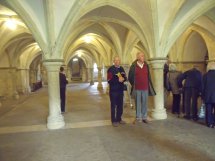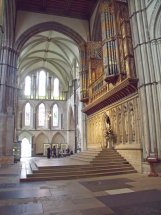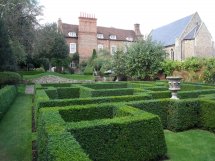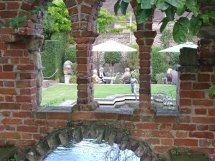Visit Reports
Rochester Visit 27th September 2012
Rochester is a compact city full of historical, architectural and literary interest. It was a spectacular arrival as we crossed the bridge over
the River Medway and saw the 11th century castle, with the tallest keep in England, standing protectively above the ancient streets.
After coffee, we met our three guides from the City of Rochester Society who were to take us in groups on our morning walking tour of Rochester’s highlights.
We started from the High St., part of Roman Watling St., and progressed to a walk through of the 900 year old Cathedral. This was an introduction that
enabled us to enjoy the Norman arches decorated with a chevron pattern in the nave; the colourful medieval wall paintings of the quire; the intricate Gothic stone
carved monks’ doorway from 1343 and further reminders of the monastic origins in the beautiful atmospheric crypt, probably the oldest surviving part of the building.


Throughout the tour walk we passed many attractive houses from the 16th, 17th and 18th century, including the stylish Minor Cannon Row, terraced houses built for the
lesser clergy in around 1723. The Poor Travellers’ House, with its delightful small garden and simple galleried Elizabethan cells, was endowed in 1579 by a local MP to
provide a free night’s lodging with a daily allowance of one pound of meat; one pound of bread; a pint of ale and four pence, which sounds very generous. Not surprisingly
they could only stay one night unless they were sick. As with many of the buildings, this one has Dickensian connections and one of his short stories,” The Seven Poor Travellers”,
describes this charitable house.


For many, the most memorable part of the day was our afternoon visit to the remarkable Restoration House, so called because Charles 11 spent a night
there on his return to London when the Monarchy was restored in 1660. Some of us were lucky enough to be shown round by the owner, Robert Tucker, who has
devoted over two decades to restoring the house and started opening it to the public twice a week during the summer months in 2000. He has revealed 17th
century wooden floors and wall colourings to take best advantage of natural light in a house lit by candles, and collected furniture, porcelain and objets d’art
from the 17th and 18th century to complement this pre Civil War gem of a town house, as well as portraits and landscapes by Gainsborough, Reynolds and Constable.
In Dickens’ time, the house had fallen into disrepair and he had it in mind when he described Satis House, home of Miss Havisham, in “Great Expectations”. Wandering
round the double walled interlinked gardens with central fishpond, clipped yews, specimen trees and colourful borders was a final delightful interlude in the autumn sunshine.
It was interesting that the journey to Rochester only took 1.5 hours from Harpenden with a good run round the M25 or one could now go directly by train, yet few of us had ever
been. Many felt that there was so much of interest that this was just an introduction, and we needed more than a day to do it justice. Several of our members told me they
intended going back, possibly for a weekend to include the Historic Dockyard Chatham as well.
Carole Sugden October 2012
